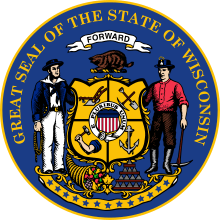James S. Brown
James Sproat Brown (February 1, 1824 – April 15, 1878) was an American lawyer and Democratic Party politician who became the first Attorney General of Wisconsin. He also served one term as mayor of Milwaukee, Wisconsin, and represented Wisconsin's 1st congressional district in the United States House of Representatives during the 38th Congress.
James S. Brown | |
|---|---|
| Member of the U.S. House of Representatives from Wisconsin's 1st district | |
| In office March 4, 1863 – March 3, 1865 | |
| Preceded by | John F. Potter |
| Succeeded by | Halbert Eleazer Paine |
| 13th Mayor of Milwaukee | |
| In office 1861–1862 | |
| Preceded by | William Pitt Lynde |
| Succeeded by | Horace Chase |
| 1st Attorney General of Wisconsin | |
| In office June 7, 1848 – January 7, 1850 | |
| Governor | Nelson Dewey |
| Preceded by | A. Hyatt Smith (territorial government) |
| Succeeded by | S. Park Coon |
| Personal details | |
| Born | February 1, 1824 Hampden. Maine |
| Died | April 15, 1878 (aged 54) Chicago, Illinois |
| Resting place | Forest Home Cemetery Milwaukee, Wisconsin |
| Political party | Democratic |
| Spouse(s) |
|
| Children |
|
| Mother | Melinda (Padelford) Brown |
| Father | Enoch Brown |
| Profession | lawyer, politician |
Early and family life
Brown was born in Hampden, Penobscot County, Maine, to Enoch Brown and his wife, the former Melinda Padelford, on February 1, 1824. He married twice. His first wife, the former Elizabeth Shepard (1835-1863) of New York, was a decade his junior and they had sons Clarence S. Brown (1856–1925) and James (1859–1913).[1] After her death and the end of the American Civil War, he returned to Maine and married widow Emily J. Stetson (1815-1902). They had no further children, and she survived him.
Career
The 16-year-old Brown moved to Cincinnati, Ohio, in 1840 and began studying law as well as learned to speak German. After being admitted to the Ohio bar in 1843, he moved west and began practicing law in Milwaukee, Wisconsin Territory, in 1844. Brown soon established a law partnership with Thomas L. Ogden, who was from New York (and with whom he lived),[2] and James Halliday. Brown was elected prosecuting attorney for Milwaukee County in 1846 (since Milwaukee had not yet been incorporated), and from 1848 to 1850 served as the first Attorney General of Wisconsin. In the heated political climate, an arsonist tried to burn down his house in 1858 but only succeeded in destroying a woodshed. Brown was also part of a group that attempted to establish a law school in Milwaukee, but failed, so the fledgling Milwaukee Bar Association remained a social group. Elected the 13th mayor of Milwaukee in 1860, Brown took office in 1861 and restored the city's credit, as well as purchased the city's first steam engine fire truck and paid fire company, but declined to run for re-election in 1862.[3]
Instead in 1862, Brown ran for Congress and defeated Republican John Fox Potter to represent Wisconsin's 1st congressional district, despite facing criticism for his handling of a bank riot in June 1861 as well as for cuts in the police budget. He served one term in the United States House of Representatives during the 38th Congress, from March 4, 1863, to March 3, 1865. In 1864 he ran for re-election and was denounced as anti-Union and ultimately withdrew from the race. Union General Halbert Eleazer Paine, a Republican, succeeded to the seat. Brown would challenge him and lose in 1866.[3]
After his term in Congress ended early in 1865, Brown married the widow of former Maine Congressman Charles Stetson, who had died in 1863. By 1869 the Browns were in Dresden, Germany. They continued to travel around Europe (as Brown had more briefly in 1854) as Brown tried to recuperate his long-precarious health. He returned to the United States in 1873, where he practiced law once again in Milwaukee and managed his various real estate investments.[3]
Death and legacy
Brown died in 1878 in Chicago, Illinois, at age 54, survived by his two sons and second wife. After a service in his Milwaukee home led by a Unitarian minister, his body was interred beside his first wife at Milwaukee's Forest Home Cemetery, where his sons would also be buried. His former house in Milwaukee (a double structure he built in 1852) survives, the oldest house in the former Yankee Hill neighborhood, and is a historic site.[3] His son Clarence Brown graduated from Harvard Law School and became an alderman.
References
- 1860 U.S. Federal Census for Ward 7 of Milwaukee, Wisconsin, family 9
- 1850 U.S. Federal Census for Ward 1, Milwaukee, Wisconsin shows him in a household with fellow lawyer
- "Historic designation study report | James S. Brown Double House" (PDF). City of Milwaukee. September 2005. Retrieved December 26, 2019.
External links
- United States Congress. "James S. Brown (id: B000922)". Biographical Directory of the United States Congress.
- James Sproat Brown at Find a Grave
| Legal offices | ||
|---|---|---|
| Preceded by A. Hyatt Smith (Wisconsin Territory) |
Attorney General of Wisconsin 1848 – 1850 |
Succeeded by S. Park Coon |
| Political offices | ||
| Preceded by William Pitt Lynde |
Mayor of Milwaukee, Wisconsin 1861 – 1862 |
Succeeded by Horace Chase |
| U.S. House of Representatives | ||
| Preceded by John F. Potter |
Member of the U.S. House of Representatives from Wisconsin's 1st congressional district March 4, 1863 – March 3, 1865 |
Succeeded by Halbert Eleazer Paine |
